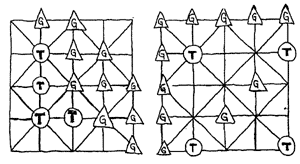 From the Himalaya to the Alps, baghchal has now traversed the continents with the First Swiss Bagh Chal Tournament held in Bern last week where 200 participants battled it out for the Bronze Tiger Trophy.
From the Himalaya to the Alps, baghchal has now traversed the continents with the First Swiss Bagh Chal Tournament held in Bern last week where 200 participants battled it out for the Bronze Tiger Trophy.
The tournament was organised by "Crazy" David Levine, who became a baghchal aficionado after a visit to Nepal. He sells baghchal sets and organised the tournament in an old church in the Swiss capital.
Bagchal is thought to have been discovered by Himalayan herders, whose occupation the game mimics. Shepherds spent many hours playing baghchal on a grid scraped into the dirt, using larger stones to represent bagh (tigers) and smaller pebbles as bakhri (goats). In Nepal, baghchal is played much the same way it has been for centuries: school children scribble a board on paper during breaks or we find grids etched into dirt patches. Today, the baghchal grid is carved into a wooden or brass game box to sell to tourists.
At the Bern tournament last week, Raya Gurung from Gorkha advanced to the semifinals with brilliant moves only to be beaten by his Swiss wife, Ruth Kaeser. Ruth played well against all opponents and was the highest-ranked woman in the tournament, eventually winning the Bronze Tiger. Silver was won by newcomer Martin Moser of Bern who played an excellent game against Daenu Wyss, which ended in a stalemate after 10 minutes. Due to time limitations, Crazy David was forced to determine a winner by coin toss, which Martin lost.
There was even a Green Trophy for the worst player, 15-year- old Samuel from Wallis in southern Switzerland. Plans are already afoot for the next Baghchal Tournament which will be held in May in the Bernese Oberland. "I love this game and the way it brings people together," Crazy David told us.
Back in the land of its origin, baghchal is in slow but steady decline. A tournament was held in Janakpur during the Panchayat days, recalls organiser Visma Jwalananda Rajopadhyaya. But since then there have been no concerted efforts to revive this ancient game. Legend has it that none other than Gautam Buddha himself was a baghchal fan. The game has a strategy similar to chess and drought. There are 25 spaces on a baghchal grid connected diagonally or on a straight line. These are the only valid lines of movement the challengers may take. The bagh attempt to leap over and devour lonely, unprotected bakhri. The bakhri find their strength in numbers. They throng together, attempting to surround the bagh and limit their movement. Just like real wild tigers in the tarai, baghchal tigers are constantly on the prowl for food. If the goats are not clever, they make an easy meal for the hungry felines.
How to play Baghchal  Requirements:
Requirements:
. A family of 4 Tigers (bagh) and a herd of 20 Goats (bakhri)
. The game board is a 25-point grid
Positions....
Baghchal is a challenge between predator and prey:
The Tigers assume their positions, one prowling on each corner of the board.
One Goat appears in the distance, cautiously occupying a vacant space on the board. Following the placement of each Goat, a Tiger stalks along the line of movement.
Note: All twenty Goats must first appear before any may move from its position.  The objective is SURVIVAL!
The objective is SURVIVAL!
To satisfy their hunger, the Tigers must "eat" a total of five Goats. Leaping over a Goat, the Tiger devours its prey. (A variation to the game may be played where the Tigers eat all the Goats.)
To protect themselves, Goats throng together, surrounding the Tigers and limiting their movement.
Tigers win when five Goats are "eaten." Goats win when all Tigers are surrounded, unable to leap over and eat the Goats or make regular movements.
Prowl or Press?
One Tiger is on the prowl at a time, moving from one space to an adjacent space along a connecting line. To get one's Goat, the Tiger leaps over an unprotected Goat along a line of movement on to an open space. The devoured Goat is removed from the board.
Once all Goats have appeared on the field, one Goat per turn moves to an adjacent space along a line of movement. Tigers cannot leap over more than one Goat so Goats must press together to protect themselves.
Note: Tigers cannot leap over Tigers or around corners and Goats cannot jump at all.
Life in the jungle continues, alternating moves between Tiger and Goat...
Strategies
"Ghost Goats" : Goats can have the Tigers by their tails, without physically occupying a space, restricting the Tigers' movements.
"Circle of Death" : To lure the Goats into their grasp, Tigers cordon the Goats, leaving two vacant spaces in front of each Tiger.


